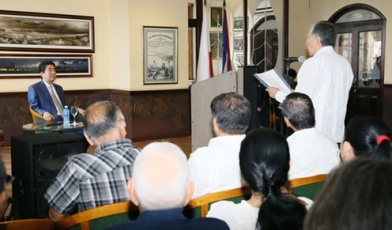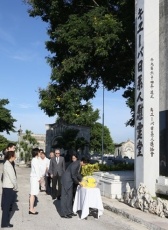Japan-Cuba Relations
Prime Minister Shinzo Abe Visits Cuba
 (Photo: Cabinet Public Relations Office)
(Photo: Cabinet Public Relations Office)
 (Photo: Cabinet Public Relations Office)
(Photo: Cabinet Public Relations Office)
Mr. Shinzo Abe, Prime Minister, visited the Republic of Cuba and participated in events in Havana from Thursday, September 22 to Friday, September 23. The overview of the outcomes is as follows. This visit by Prime Minister Abe was the first visit to Cuba by a Japanese Prime Minister.
I. Overview
 (Photo: Alex Castro
(Photo: Alex Castro (Photo: Cabinet Public Relations Office)
(Photo: Cabinet Public Relations Office) (Photo: Cabinet Public Relations Office)
(Photo: Cabinet Public Relations Office)
1. Itinerary
(1) Thursday, September 22
- Meeting with H.E. Mr. Fidel Castro Ruz, former President of the Council of State of Cuba
- Gathering with Cubans of Japanese descent
- Wreath Laying Ceremony at the José Martí Memorial
- Welcoming ceremony
- Japan-Cuba Summit Meeting
- Grant aid signing ceremony
- Dinner hosted by H. E. Mr. Raúl Castro Ruz, President of the Council of State of Cuba
(2) Friday, September 23
- Domestic and foreign press conferences
- Floral Tribute at the Memorial Monument for Cubans of Japanese Descent
- Visit to Old Havana
2. Events
(1) Meeting with former President Castro
 (Photo: Alex Castro)
(Photo: Alex Castro)
 (Photo: Alex Castro)
(Photo: Alex Castro)
(2) Gathering with Cubans of Japanese descent
 (Photo: Cabinet Public Relations Office)
(Photo: Cabinet Public Relations Office)
 (Photo: Cabinet Public Relations Office)
(Photo: Cabinet Public Relations Office)
On Thursday, September 22, Prime Minister Abe and his wife attended an informal gathering with Cubans of Japanese descent at the Meliá Cohiba Hotel in Havana City.
54 Cubans of Japanese descent attended the gathering, including Mr. Francisco Miyasaka, President of the Japanese Cuban Society, Mr. Noboru Miyazawa, President of the Isle of Youth’s Japanese Cuban Association, Mr. Antonio Yohena, President of the Cuba Okinawa Association, and Mr. Okada (a Cuban of Japanese descent from Yamaguchi Prefecture). Prime Minister Abe delivered a greeting in which he expressed respect for the efforts and hardships of Cubans of Japanese descent, as well as his strong pride in the high appreciation that Cuba has for Japanese people’s industriousness as a result of Cubans of Japanese descent. Mr. Miyasaka explained that Japanese people who settled in Cuba had a positive impact on the people of Cuba by bestowing Japanese people’s virtues on their descendants and on Cubans, and the Japanese Cuban Society intends to make a greater contribution to developing relations between the two countries.
(3) Wreath Laying Ceremony at the José Martí Memorial
 (Photo: Cabinet Public Relations Office)
(Photo: Cabinet Public Relations Office) (Photo: Cabinet Public Relations Office)
(Photo: Cabinet Public Relations Office) (Photo: Cabinet Public Relations Office)
(Photo: Cabinet Public Relations Office)
On Thursday, September 22, Prime Minister Abe and his wife offered flowers at the José Martí Memorial in Revolution Square in Havana City, and visited the José Marti Memorial Museum.
(4) Welcoming ceremony
 (Photo: Cabinet Public Relations Office)
(Photo: Cabinet Public Relations Office)
On Thursday, September 22, Prime Minister Abe was welcomed by President Castro before attended a welcoming ceremony held at the Council of State.
(5) Japan-Cuba Summit Meeting
 (Photo: Cabinet Public Relations Office)
(Photo: Cabinet Public Relations Office) (Photo: Cabinet Public Relations Office)
(Photo: Cabinet Public Relations Office) (Photo: Cabinet Public Relations Office)
(Photo: Cabinet Public Relations Office)
(6) Grant aid signing ceremony
 (Photo: Cabinet Public Relations Office)
(Photo: Cabinet Public Relations Office)
 (Photo: Cabinet Public Relations Office)
(Photo: Cabinet Public Relations Office)
On Thursday, September 22, a signing and exchange of notes on the “Project for the Installation of Medical Equipment to Improve Healthcare Services in Cuba’s Main Hospitals” grant aid took place between Mr. Masaru Watanabe, Japanese Ambassador to Cuba, and Mr. Rodrigo Malmierca Díaz, Minister of Foreign Trade and Investment, in the presence of Prime Minister Abe and President Castro.
(7) Dinner hosted by President Castro
On Thursday, September 22, Prime Minister Abe and his wife attended a dinner hosted by President Castro at the Council of State.
(8) Floral Tribute at the Memorial Monument for Cubans of Japanese Descent
 (Photo: Cabinet Public Relations Office)
(Photo: Cabinet Public Relations Office) (Photo: Cabinet Public Relations Office)
(Photo: Cabinet Public Relations Office) (Photo: Cabinet Public Relations Office)
(Photo: Cabinet Public Relations Office)
On Friday, September 23, Prime Minister Abe and his wife offered prayers and flowers at the Memorial Monument for Cubans of Japanese Descent in the Colon Cemetery in Havana City.
(9) Visit to Old Havana
On Friday, September 23, commencing at 9:30 a.m. (local time. 10:30 p.m., September 23, Japan time) for approximately 50 minutes, Prime Minister Abe and his wife visited Old Havana, which was inscribed as a World Heritage Site in 1982, and viewed the Hasekura Tsunenaga Monument, the Plaza de Armas, the Palacio de los Capitanes Generales, the Hotel Ambos Mundos, the Casa de Asia (House of Asia) and the Plaza Vieja (Old Square). At the Casa de Asia they visited a stone monument of the Hiroshima atomic bomb site, and at the Plaza Vieja they visited a planetarium that received equipment as a result of cultural grant aid from Japan.
II. Assessment
(1) First visit to Cuba by a Japanese Prime Minister
This was the first visit to Cuba by a Japanese Prime Minister, and the first summit meeting with President Castro. This visit turned a new page in the more than 400-year history of friendship between the two countries.
In the summit meeting, it was confirmed that relations will be strengthened in a variety of fields through fora such as discussions between foreign ministers, that bilateral cooperation and cooperation in the international arena will be accelerated, and that the partnership will be strengthened in various fields.
(2) Strengthening of economic relations
Japanese private-sector companies’ interest in the Cuban market is increasing following the reestablishment of diplomatic relations between the United States and Cuba last year. The Government of Cuba is promoting the introduction of foreign investment in modernization of Cuba’s socioeconomic model, and there is also growing expectation towards investment from Japan.
In this summit meeting, the view was shared that Japanese investment has a significant role to play in the development of Cuba. Collaboration by both countries’ public and private sectors will move ahead for the purpose of strengthening economic relations, including investment.
(3) Promotion of full-fledged economic cooperation
Massive infrastructure demand exists in Cuba, including in the fields of transport and energy, and so in order to promote full-fledged economic cooperation, it was decided to set up a Japan International Cooperation Agency (JICA) office.
office.
(4) Strengthening of relations with Cuba, which continues to make its presence felt as a leader of the Non-Aligned Movement countries
 (Photo: Cabinet Public Relations Office)
(Photo: Cabinet Public Relations Office)
 (Photo: Cabinet Public Relations Office)
(Photo: Cabinet Public Relations Office)
It was possible to build a relationship of trust at the leader level with Cuba, which among the 100 or more Non-Aligned Movement countries worldwide is a leader-like entity for developing countries and makes its presence felt by representing their standpoint. It was possible to convey Japan’s contributions and standpoints with regard to the challenges facing the international community, directly to President Castro.
 (Photo: Cabinet Public Relations Office)
(Photo: Cabinet Public Relations Office)


